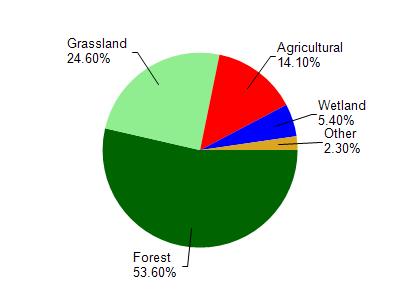Iowa
Yes
No
No
Fish and Aquatic Life
Overview
Cave Hollow Creek is a spring fed stream with a limestone bedrock bottom. The stream is shallow with lots of riffles, but few pools. It is currently listed as a Class II trout fishery, but has very limited in-stream habitat. Stream health is affected by nonpoint source pollution from heavy streambank pasturing and cropland erosion which have contributed to heavily silted in conditions. Road culverts limit fish migration in the stream.
From: Ripp, Coreen, Koperski, Cindy and Folstad, Jason. 2002. The State of the Lower Wisconsin River Basin. PUBL WT-559-2002. Wisconsin Department of Natural Resources, Madison, WI.
Date 2002
Author Cynthia Koperski
Historical Description
Cave Hollow Stream - Mouth location T6N R2E Section 17 - 8, Surface area = 2.0, Length = 2.0 miles, Gradient = 34.6 feet per mile, Total alkalinity = 258 mg/l, Volume of flow = 0.5 cfs.
Cave Hollow Stream is so named because of a rock overhang in the limestone bluffs which exist along its banks. It is fed by several good springs located throughout its length; however, it is not classified or managed as trout water sine there is an absence of pools and deep enough water to support this species.
Although its immediate drainage basin is fairly heavily wooded, over eight-tenths of its watershed land area is devoted to agriculture. There is moderate erosion of its banks, and flood conditions exist during periods of heavy precipitation. Waterfowl and marshland furbearers make little use of this stream because of its small size and the well-drained condition of its watershed. A sport fishery is lacking, but the possibility that some trout exist near its mouth is due to its confluence with Otter Creek. A brief seining survey showed that species of fishes that are known to be present include blacknose dace, johnny darter, and hognose suckers. There are no public lands along the stream but it is accessible from a town road crossing.
From: Piening, Ronald and Threinen, C.W., 1968. Lake and Stream Classification Project. Surface Water Resources of Iowa County, Wisconsin Department of Natural Resources, Madison, WI.
Date 1968
Author Surface Water Inventory Of Wisconsin
Condition
Wisconsin has over 84,000 miles of streams, 15,000 lakes and milllions of acres of wetlands. Assessing the condition of this vast amount of water is challenging. The state's water monitoring program uses a media-based, cross-program approach to analyze water condition. An updated monitoring strategy (2015-2020) is now available. Compliance with Clean Water Act fishable, swimmable standards are located in the Executive Summary of Water Condition in 2018. See also the 'monitoring and projects' tab.
Management Goals
Wisconsin's Water Quality Standards provide qualitative and quantitative goals for waters that are protective of Fishable, Swimmable conditions [Learn more]. Waters that do not meet water quality standards are considered impaired and restoration actions are planned and carried out until the water is once again fishable and swimmable
Management goals can include creation or implementation of a Total Maximum Daily Load analysis, a Nine Key Element Plan, or other restoration work, education and outreach and more. If specific recommendations exist for this water, they will be displayed below online.
Monitoring
Monitoring the condition of a river, stream, or lake includes gathering physical, chemical, biological, and habitat data. Comprehensive studies often gather all these parameters in great detail, while lighter assessment events will involve sampling physical, chemical and biological data such as macroinvertebrates. Aquatic macroinvertebrates and fish communities integrate watershed or catchment condition, providing great insight into overall ecosystem health. Chemical and habitat parameters tell researchers more about human induced problems including contaminated runoff, point source dischargers, or habitat issues that foster or limit the potential of aquatic communities to thrive in a given area. Wisconsin's Water Monitoring Strategy was recenty updated.
Grants and Management Projects
Monitoring Projects
| WBIC | Official Waterbody Name | Station ID | Station Name | Earliest Fieldwork Date | Latest Fieldwork Date | View Station | View Data |
|---|
| 1239700 | Cave Hollow Creek | 10022670 | Cave Hollow Cr DS of Cave Hollow Rd | | | Map | Data |
| 1239700 | Cave Hollow Creek | 253120 | Cave Hollow Creek | 4/17/2006 | 4/17/2006 | Map | Data |
| 1239700 | Cave Hollow Creek | 10014374 | Cave Hollow Creek-Downstream Cave Hollow Rd | | | Map | Data |
| 1239700 | Cave Hollow Creek | 10022668 | Cave Hollow ~330M US Otter Cr confluence | | | Map | Data |
|

Watershed Characteristics
Cave Hollow Creek is located in the Otter and Morrey Creeks watershed which is 198.69 mi². Land use in the watershed is primarily forest (53.60%), grassland (24.60%) and a mix of agricultural (14.10%) and other uses (7.70%). This watershed has 437.57 stream miles, 351.55 lake acres and 5,785.74 wetland acres.
Nonpoint Source Characteristics
This watershed is ranked Not Ranked for runoff impacts on streams, Low for runoff impacts on lakes and High for runoff impacts on groundwater and therefore has an overall rank of High. This value can be used in ranking the watershed or individual waterbodies for grant funding under state and county programs.However, all waters are affected by diffuse pollutant sources regardless of initial water quality. Applications for specific runoff projects under state or county grant programs may be pursued. For more information, go to surface water program grants.